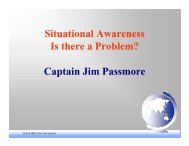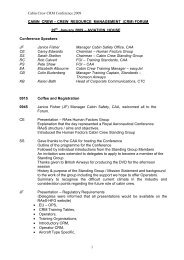Culture, Error, and Crew Resource Management - Human Factors ...
Culture, Error, and Crew Resource Management - Human Factors ...
Culture, Error, and Crew Resource Management - Human Factors ...
Create successful ePaper yourself
Turn your PDF publications into a flip-book with our unique Google optimized e-Paper software.
<strong>Culture</strong>, <strong>Error</strong>, <strong>and</strong> CRM 5<br />
A safety culture is the outcome that organizations reach through a strong commitment to acquiring<br />
necessary data <strong>and</strong> taking proactive steps to reduce the probability of errors <strong>and</strong> the severity of those that occur<br />
(Merritt & Helmreich, 1997). A safety culture includes a strong commitment to training <strong>and</strong> to reinforcing safe<br />
practices <strong>and</strong> establishing open lines of communication between operational personnel <strong>and</strong> management regarding<br />
threats to safety. In our data collection we ask a number of questions about perceptions of management’s<br />
commitment to safety. Table 1 shows the percentage agreeing with two items in two organizations.<br />
Item<br />
%<br />
Agreement<br />
Airline A<br />
%<br />
Agreement<br />
Airline B<br />
I know the correct safety channels to direct queries 85 57<br />
My safety suggestions would be acted on 68 19<br />
Table 1. Percentage of pilots agreeing with two safety items on the Flight <strong>Management</strong> Attitudes Questionnaire.<br />
While the majority of pilots in each organization indicate that they know the proper channels for<br />
communicating safety concerns, the percentage is substantially lower in Airline B. More telling are the differences in<br />
the percent that believe their safety suggestions would be acted on. This ranges from 68% in Airline A to 19% in<br />
Airline B, but even in Airline A, there is obvious skepticism about the organization’s commitment to safety.<br />
Organizational practices clearly determine the pride that individuals have in working for an organization.<br />
These attitudes undoubtedly exert an influence, although indirectly, on safety <strong>and</strong> compliance. In one airline, 97% of<br />
the pilots agreed with the statement ‘I am proud to work for this organization’ while at another, fewer than 20%<br />
agreed. Similar variability was found in attitudes regarding trust in senior management. The organizational culture is<br />
important because when it is strong <strong>and</strong> positive, pilots <strong>and</strong> other groups may more readily accept new concepts such<br />
as CRM <strong>and</strong> its associated training.<br />
National <strong>Culture</strong> in Aviation<br />
The view has been widespread in aviation that the cockpit is a culture free zone, one in which pilots of all<br />
nationalities accomplish their common task of flying safely from one point to another. Data, however, have begun to<br />
accumulate suggesting that there are substantial differences in the way pilots conduct their work as a function of<br />
national culture <strong>and</strong> that the areas of difference have implications for safety (Helmreich & Merritt, 1998; Johnston,<br />
1993; Merritt, 1996; Merritt & Helmreich, 1996a; Merritt & Helmreich, 1996b; Sherman, Helmreich, & Merritt,<br />
1997).<br />
Geert Hofstede’s (1980, 1991) four dimensional model of culture has proved to be a useful starting place to<br />
examine the effects of national culture on flightdeck behavior. We took his survey of work attitudes as a benchmark<br />
<strong>and</strong> augmented his questions with a new set of items that were more directly relevant to the aviation environment<br />
(Helmreich & Merritt, 1998). Three of Hofstede’s four dimensions replicated <strong>and</strong> proved to be conceptually relevant<br />
to team interactions in the cockpit.<br />
The first, Power Distance (PD), reflects the acceptance by subordinates of unequal power relationships <strong>and</strong><br />
is defined by statements indicating that juniors should not question the decisions or actions of their superiors <strong>and</strong> the<br />
nature of leadership (i.e., consultative versus autocratic). Figure 4 shows mean scores on our measure of Power<br />
Distance, the Comm<strong>and</strong> Scale, of pilots from 22 nations. High scores on the scale indicate high Power Distance <strong>and</strong><br />
acceptance of a more autocratic type of leadership. In high PD cultures, safety may suffer from the fact that followers<br />
are unwilling to make inputs regarding leaders’ actions or decisions. Countries such as Morocco, the Philippines,<br />
Taiwan, <strong>and</strong> Brazil have the highest scores, indicating the highest acceptance of unequally distributed power. At the<br />
other end of the Power continuum are found countries such as Irel<strong>and</strong>, Denmark, <strong>and</strong> Norway, with the USA also<br />
scoring at the low end of the distribution.




